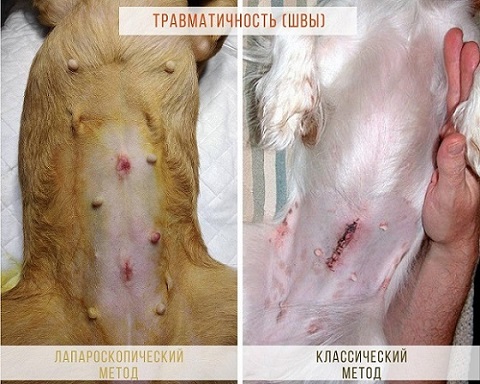Laparoscopy

About method
Castration by endoscopic method is:
- Fast, efficient and safe (cat - one prick, dog - two pricks)
- No contact of internal organs with the environment (no risk of infection), detailed visualization of operated organs
- The laparoscopic method allows you to perform the operation from the age of two months (relevant for animals from shelters and nurseries)
Castration or sterilization?
Despite the fact that in everyday life it is understood that males are castrated and females are sterilized, from the point of view of medical terminology this is not at all the case:
- Castration - removal of the gonads. After this operation, the animal cannot have offspring (becomes sterile), there is no production of sex hormones (there are no sexual changes - marks, inappropriate behavior, aggression, vocalization).
- Sterilization - bandaging or crossing the pathways of germ cells (the spermatic cords in males or the uterine horns in females). After this operation, the animal cannot have offspring (becomes sterile), but due to the continued production of sex hormones, all sexual characteristics (marks, smell of urine, aggressiveness, mating, vocalization) are preserved.
Animals (both females and males) are castrated. Sterilization is carried out most often to people (for medical reasons).
Endoscopy or laparoscopy?
The difference between these terms is not significant. Endoscopy is an intervention using an endoscope in any body cavity (intestines, sinuses, esophagus...). Laparoscopy - carrying out manipulations within the abdominal cavity.
Postoperative period
We have come to minimize stress for both the pet and the owner.
- One hour after surgery animal eats and plays
- No seams left, no need collars, blankets, trimmings
- The postoperative period after laparoscopic surgery is not required. Your pet continues to lead a normal active life immediately after the visit to the clinic. Your pet will not require any special postoperative care.
Anesthesia
Anesthesiologists at the Zoolux clinic use inhalation, epidural and total intravenous anesthesia for operations. After the preoperative examination, the anesthesiologist will select the most effective and safe combination of drugs and types of anesthesia for the operation.
- The combination of different types of anesthesia - a minimum of risks
- Minimal incisions - short duration of anesthesia - quick awakening
- Anesthesia and vital signs are continuously monitored by the anesthesiologist throughout the operation and during awakening
Questions? - Discuss with a medical practitioner
(094)828-98-38


